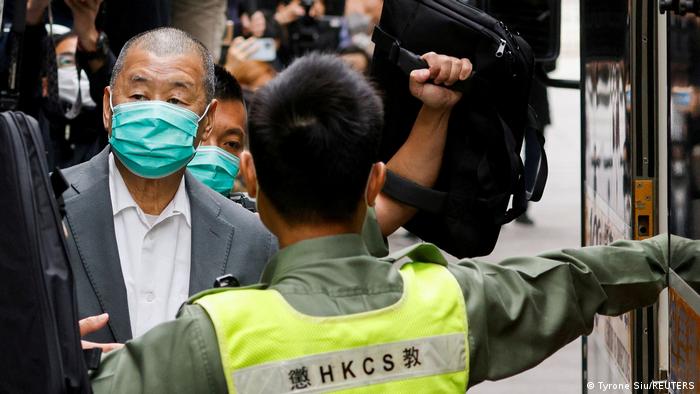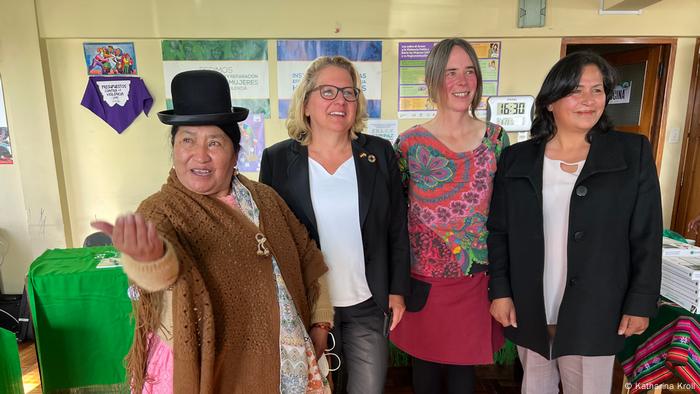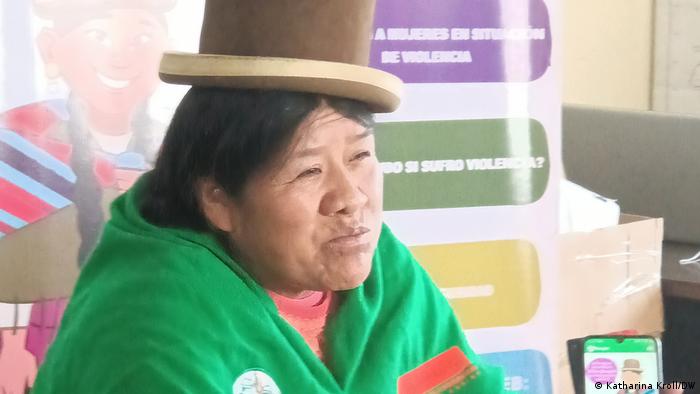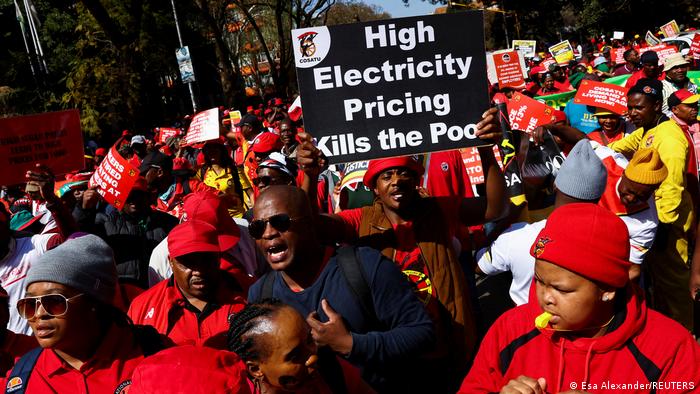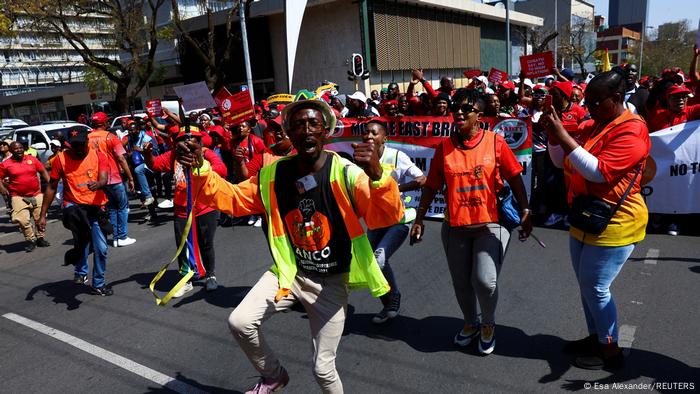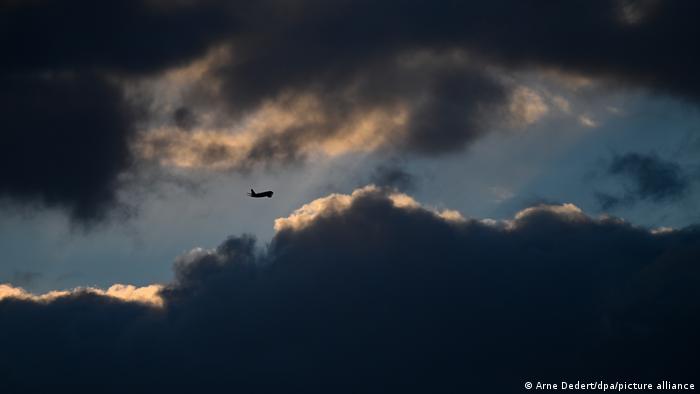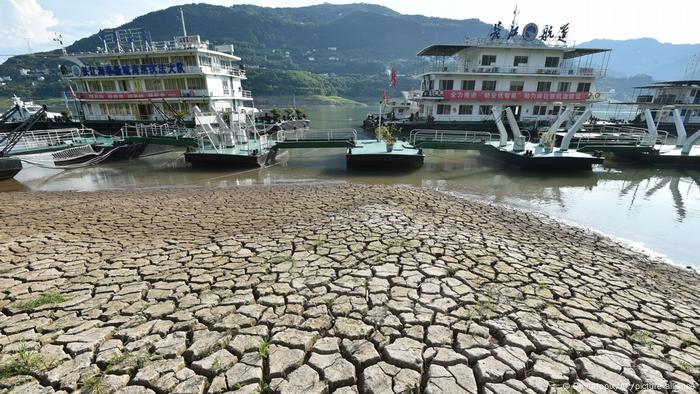Issued on: 30/08/2022 -
Video by: Catherine CLIFFORD
Nearly half a million people crowded into camps after losing their homes in widespread flooding and the climate minister warned Monday that Pakistan is on the “front line” of the world's climate crisis, after unprecedented monsoon rains that began in mid-June wracked the country, killing more than 1,130 people.
A third of Pakistan was underwater as a result of flooding caused by record monsoon rains, Climate Change Minister Sherry Rehman said Monday, creating a crisis of "unimaginable proportions".
"It's all one big ocean, there's no dry land to pump the water out," she said.
The rains stopped more than two days ago, and floods in some areas were receding.
But Pakistanis in many parts of the country were still wading through waters that filled their homes or covered their town's streets as they struggled with how to deal with the damage to homes and businesses.
In one of the worst single incidents of the flooding, at least 11 people were killed Monday when a boat that volunteer rescuers were using to evacuate two dozen people capsized in the flood-swollen waters of the Indus River near the southern city of Bilawal Pur, media reported. An unknown number were still missing from the capsizing.
Rehman and meteorologists told The Associated Press that new monsoons were expected in September. Monsoons have hit earlier and more heavily than usual since the start of summer, officials say – most recently with massive rains last week that affected nearly the entire country.
Pakistan is accustomed to monsoon rains and flooding, Rehman said, but not like this.
“What we saw recently in the last eight weeks is unrelenting cascades of torrential rain that no monsoon has ever brought with it ever before,” she said.
The heavy rains are the latest in a series of catastrophes that Rehman said are exacerbated by climate change, including heatwaves, forest fires and glacial lake outbursts. The damage reflects how poorer countries often pay the price for climate change largely caused by more industrialised nations. Since 1959, Pakistan is responsible for only 0.4 percent of the world’s historic CO2 emissions. The US is responsible for 21.5 percent, China for 16.5 percent and the EU 15 percent.
“Climate knows no borders and its effects can be disproportionately felt," Rehman said. "When you see low pressure systems coming from the Bay of Bengal, they hit us before anyone. So we’re on the front line of a global crisis.”
The National Disaster Management Authority said floods this summer have killed more than 1,136 people and injured 1,636 as well as damaging 1 million homes. At least 498,000 people in the country of 220 million are in relief camps after being displaced, it said. Many more displaced are believed to be living with relatives, friends or outside.
'I lost everything'
International aid was starting to flow into Pakistan, and the military was helping distribute aid to remote areas and evacuate those who had lost their homes. Authorities were starting the long effort of rebuilding roads and restarting railways. The floods destroyed more than 150 bridges and numerous roads have been washed away, making rescue operations difficult.
In the southeastern town of Shikar Pur not far from the Indus River, Rehan Ali dug up bricks from the collapsed walls of his home, nearly completely destroyed by lashing storms and waters that raged through. His family’s possessions were strewn around outside.
The 24-year-old labourer said he cannot rebuild without government help and can’t work now because of the turmoil. “I don’t even have anything to feed my family. I lost everything. I don’t know where to go. God help me,” he said.
Arif Ullah, an official at the Pakistan Meteorological Department, told the AP that more rains will continue to lash parts of Pakistan next month.
Prime Minister Shahbaz Sharif on Monday said the rains so far have been the heaviest Pakistan has seen in three decades.
“I saw floodwater everywhere, wherever I went in recent days and even today,” Sharif said in the town of Charsadda in the northeast of the country. Some 180,000 people in the town have been evacuated after the Swat River overflowed and swamped nearby communities.
Sharif has said the government would provide housing to all those who lost their homes.
But many of the displaced have lost not just homes, but also crops and businesses.
“I am sitting with my family in a tent, and how can I go out to work? Even if I go out in search of a job, who will give me any job as there is water everywhere,” asked Rehmat Ullah, a flood victim in Charsadda.
Zarina Bibi said soldiers evacuated her by boat. She broke down in tears as she recounted how her house collapsed in the floods.
“We were given a tent and food by soldiers and volunteers,” she said. “Floodwater will recede soon, but we have no money to rebuild our home.”
UN to launch appeal for flood victims
At least 6,500 soldiers were deployed to help, and authorities said they were using military planes, helicopters, trucks and boats to evacuate marooned people and deliver aid to them.
However, many of the displaced complained they were still waiting for help. Some said they got tents but not food.
Pakistani authorities say this year’s devastation is worse than in 2010, when floods killed 1,700 people. General Qamar Javed Bajwa, Pakistan’s military chief, said Sunday that his country may take years to recover. He appealed to Pakistanis living abroad to generously donate to the flood victims.
Cargo planes from Turkey and the United Arab Emirates began the flow of international aid, landing in Islamabad on Sunday with tents, food and other daily necessities. The United Nations will launch an international appeal for Pakistani flood victims on Tuesday in Islamabad.
The flood wreckage has hit Pakistan at a time when the country faces one of its worst economic crises, narrowly avoiding a default.
The International Monetary Fund’s executive board on Monday approved the release of a much-awaited $1.17 billion for Pakistan, Pakistan's Information Minister Maryam Aurangez told the AP.
Pakistan and the IMF originally signed a bailout accord in 2019, but the release of a $1.17 billion tranche had been on hold since earlier this year, when the IMF expressed concern about Pakistan’s compliance with the deal’s terms under former prime minister Imran Khan’s government.
Last week, the United Nations in a statement said that it has allocated $3 million for UN aid agencies and their partners in Pakistan to respond to the floods and this money will be used for health, nutrition, food security, and water and sanitation services in flood-affected areas, focusing on the most vulnerable.
(FRANCE 24 with AFP and AP)
Ashraf Khan, with Zain Zaman Janjua and Emma Clark in Nowshera
Mon, August 29, 2022

Aid efforts ramped up across flooded Pakistan on Tuesday to help tens of millions of people affected by relentless monsoon rains that have submerged a third of the country and claimed more than 1,100 lives.
The rains that began in June have unleashed the worst flooding in more than a decade, washing away swathes of vital crops and damaging or destroying more than a million homes.
Authorities and charities are struggling to accelerate aid delivery to more than 33 million people affected, a challenging task in areas cut off because roads and bridges have been washed away.
In the south and west, dry land is limited, with displaced people crammed onto elevated highways and railroad tracks to escape the flooded plains.

"We don't even have space to cook food. We need help," Rimsha Bibi, a schoolgirl in Dera Ghazi Khan in central Pakistan, told AFP.
Pakistan receives heavy -- often destructive -- rains during its annual monsoon season, which are crucial for agriculture and water supplies.
But such intense downpours have not been seen for three decades.
Pakistani officials have blamed climate change, which is increasing the frequency and intensity of extreme weather around the world.

"To see the devastation on the ground is really mind-boggling," Pakistan's climate change minister Sherry Rehman told AFP.
"When we send in water pumps, they say 'Where do we pump the water?' It's all one big ocean, there's no dry land to pump the water out."
She said "literally a third" of the country was under water, comparing scenes from the disaster to a dystopian movie.
Planning Minister Ahsan Iqbal said Pakistan needed more than $10 billion to repair and rebuild damaged infrastructure.
"Massive damage has been caused... especially in the areas of telecommunications, roads, agriculture and livelihoods," he told AFP Tuesday.
The Indus River, which runs along the length of the South Asian nation, is threatening to burst its banks as torrents of water rush downstream from its tributaries in the north.
Pakistan as a whole had been deluged with twice the usual monsoon rainfall, the meteorological office said, but Balochistan and Sindh provinces had seen more than four times the average of the last three decades.
- International help -
The disaster could not have come at a worse time for Pakistan, where the economy is in free fall.

Appealing for international help, the government has declared an emergency.
Aid flights have arrived in recent days from Turkey and the UAE, while other nations including Canada, Australia and Japan have also pledged assistance.
The United Nations has announced it will launch a formal $160 million appeal on Tuesday to fund emergency aid.
Pakistan was already desperate for international support and the floods have compounded the challenge.

Prices of basic goods -- particularly onions, tomatoes and chickpeas -- are soaring as vendors bemoan a lack of supplies from the flooded breadbasket provinces of Sindh and Punjab.
There was some relief on Monday when the International Monetary Fund approved the revival of a loan programme for Pakistan, releasing an initial $1.1 billion.
Makeshift relief camps have sprung up all over Pakistan -- in schools, on motorways and in military bases.
In the northwestern town of Nowshera, a technical college was turned into a shelter for up to 2,500 flood victims.
They sweltered in the summer heat with sporadic food aid and little access to water.
"I never thought that one day we will have to live like this," said 60-year-old Malang Jan.
"We have lost our heaven and are now forced to live a miserable life."
bur-qan/fox/cwl/kma/leg
By Staff Report
ISLAMABAD: The military stepped up efforts on Monday to rescue hundreds of thousands of people marooned by floods and facing severe shortages of food in the southern and northwestern parts of the country.
An estimated one million have been affected by heavy rainfall, flash floods and landslides since July as Pakistan endured more than 60 percent of its normal total monsoon rainfall in three weeks.
With little aid from a weak civilian government, many flood victims are pinning hopes on the military as the only institution capable of helping them rebuild their lives.
Survivors of the nation’s worst rains and flash floods in history are increasingly impatient over a lack of food and relief goods, and are criticising the government of Prime Minister Shehbaz Sharif for mismanagement.
Some villagers have been living on rooftops for days, while others are eating plants and leaves after exhausting food stocks.
An Inter-Services Public Relations (ISPR) statement said the Pakistan Army on Monday continued relief and rescue operation in flood-hit towns of Sindh, Punjab and Balochistan.
Its troops were engaged with the civil administration in assisting relief and rescue operations in the provinces hit by record rains and flash floods.
The chief military spokesperson said the troops were engaged in shifting affectees to safe areas besides also distributing rations among them.
In Sindh, it said soldiers reached the flood-hit town of Saim Nullah in district Khairpur to safeguard the victims after flooding damaged more than 200 houses.
Troops from the garrison city of Pano Aqil who took part in the efforts shifted the victims to safe locations and a group of military doctors provided immediate medical aid.
Whereas in Balochistan, soldiers from Pakistan Army and Frontier Corps continue to provide assistance to civil administration in their relief efforts in the cities of Quetta, Pishin, Qila Saif Ullah, Ziarat, Zhob, Loralai and Noshki.
“Teams of Pakistan Army, FC, PDMA [Provincial Disaster Management Authority] and civil administration are shifting people to safer places where they are being served with cooked food and other amenities.
Relief camps have been established in Naseerabad, Duki and Lasbela areas,” the ISPR said.
It further shared that free medical camps were also established in flood-affected areas while all-out efforts are being made to restore communication infrastructure at the earliest.
In Punjab, Pakistan Army is carrying out relief activities and providing medical care to the affected people in the cities of Vehari, Rajanpur and Dera Ghazi Khan.
Zain Zaman Janjua and Emma Clark
Mon, August 29, 2022

Makeshift camps have sprung up all over Pakistan -- in schools, along motorways and at military bases -- to give shelter to millions of displaced flood victims.
But the relief at finding safety can turn to desperation for many.
In the northwestern town of Nowshera, a technical college was turned into a shelter for up to 2,500 flood victims, who sweltered in the summer heat with sporadic food aid and little access to water for bathing.
"We have been only eating rice for the past three days," 60-year-old Malang Jan told AFP.
"I never thought that one day we will have to live like this. We have lost our heaven and are now forced to live a miserable life."
Jan's family were rescued by boat when his home was submerged in the floods that have swamped a third of the country, killing more than 1,100 people and affecting tens of millions more.
The college gardens are lined with tents -- the classrooms are filled with the families who arrived first and grabbed the chance for privacy.

Others rest shoulder-to-shoulder in corridors with their meagre bundles of belongings.
Goats and chickens salvaged from the rising water graze in the campus courtyard.
The camp of 2,500 is managed by various charities, political parties and administrative officials overwhelmed by the scale of the disaster.
Volunteers hand out tents, mattresses, water, daal and naan.
"It's a situation of panic," said Mushfiq ur Rehman, a district court official who stepped in to oversee food delivery for the local administration.
"There is enough food, but people are getting desperate because they don't trust if they will get a meal again or not."
- 'We're humiliated' -
It is particularly difficult for women in this deeply conservative region of the country, where the all-covering burqa is commonly worn, and women rarely mix with men who are not relatives.

"We are Pashtun people; we don't come out of our homes often, but now we are forced to come out," said Yasmin Shah, 56, who is sheltered in a classroom with her family.
Young women with burqas pulled up over their heads watch from upper floors.
"I cannot come out of this classroom unless I have to," added another, looking after a blind uncle.
Older women take their place in queues to ensure they get a share of food handouts.
The heat is worsened when the few working fans stop working because of power cuts. There are no showers and only a few toilets available for the displaced.
"Our self respect is at stake... I stink but there is no place to take a shower," said Fazal e Malik, who is staying with seven family members in a tent.
"Our women are also facing problems and they too feel humiliated."
When food aid arrives at the college, desperate families mob the trucks, and are sometimes pushed back by police armed with long sticks.

"People send relief goods here but the distribution is not well organised at all," Yasmin said.
"There are routine scuffles and people have to fight to get some food. In the end, some people have a bigger share and others have nothing."
The largest camp in the town was set up at the Pakistan Air Force academy centre, sheltering a further 3,000 people in the accommodation usually reserved for training staff.
Nearby, armed members of a local political party have stepped in to protect abandoned homes, using rowing boats to navigate the flooded streets and watch for looters.
For some fleeing the deluge across the country, the only dry areas are elevated roads and railroad tracks, alongside which tens of thousands of poor rural folk have taken shelter with their livestock.
zz-ecl/fox/qan
Issued on: 29/08/2022 -
Islamabad (AFP) – The IMF has approved an agreement to revive a massive loan programme for Pakistan, the finance minister said Monday, as the country grapples with devastating monsoon flooding that has worsened an economic crisis.
"We should now be getting the 7th & 8th tranche of $1.17 billion," Miftah Ismail said on Twitter.
The original $6-billion bailout package with the International Monetary Fund was signed by former prime minister Imran Khan in 2019, but repeatedly stalled when his government reneged on agreed reforms on subsidies and failed to significantly improve tax collection.
The new agreement follows months of deeply unpopular belt-tightening by the government of Shehbaz Sharif, who took power in April and has effectively eliminated fuel subsidies and introduced new measures to broaden the tax base.
The government reached an agreement with IMF staff last month to restart the suspended aid package.
The board of the Washington-based crisis lender also was considering a request to extend the package through June 2023 and add about $1 billion to the total.
The IMF had not yet issued a statement on its decision.
The latest disbursement would bring the total received under the Extended Fund Facility from the IMF to just over $4 billion.
Desperate for aid
Pakistan is desperate for international support for its economy, which suffers from poor revenue collection and dwindling foreign reserves to pay its crippling debt.
The new government has slashed a raft of subsidies to meet the demands of global financial institutions but risks the wrath of an electorate already struggling under the weight of double-digit inflation.
A new coalition government -- which came to power after Khan was ousted by a parliamentary no-confidence vote -- has said it will make the tough decisions needed to turn the economy around.
Successive administrations blame their predecessors for the country's economic woes, but analysts say the malaise stems from decades of poor management and a failure to tackle endemic corruption and widespread tax avoidance.
In a bid to secure the IMF loan, Sharif has imposed three fuel price hikes -- cumulatively totalling 50 percent -- and raised the cost of electricity to effectively end the subsidies introduced by Khan.
Ismail told the national assembly last month that the steps were "essential" to preserve the country from default.
"We knew it would damage our political reputation, but still we did it," he said.
The latest budget has earmarked 3.95 trillion rupees ($18.8 billion) just to service the country's whopping debt of $128 billion.
Under the deal agreed with the IMF last month, policy priorities included steadfast implementation of the budget to reduce the need to borrow.
Pakistan also agreed to continue power sector reforms, introduce a proactive monetary policy to tackle inflation, strengthen governance, combat corruption and improve the social security net.
But the IMF warned that authorities should stand ready to take any additional measures necessary.
© 2022 AFP
Pakistan floods fuel 'back-breaking' food inflation
Kaneez FATIMA
Tue, August 30, 2022

Catastrophic monsoon floods in Pakistan have sent food prices skyrocketing, putting many staples out of the reach of the poor as the cash-strapped nation battles shortages.
The floods have submerged a third of the country, killing more than 1,100 people and affecting over 33 million.
Recovery could cost more than $10 billion, according to the planning minister.
The rains -- which began in June, and whose unusual intensity has been blamed on climate change -- have also damaged vast swathes of rich agricultural land and crops. Parts of the mountainous north and breadbasket south have been cut off because roads and bridges have been washed away.
"Things are so expensive because of this flood that we can't buy anything," said Zahida Bibi, who had come to a market in the central city of Lahore to get vegetables for dinner.
She told AFP she had to forego some items on her shopping list because inflation had put them out of reach.
"What can we do? We don't make enough money to buy things at such high prices."
Onions and tomatoes -- common ingredients in most Pakistani meals -- have been affected the most.

The prices of both had increased by 40 percent, the Pakistan Bureau of Statistics said Friday.
But on Monday, Finance Minister Miftah Ismail said the price of onions had shot up by more than five times, and that the government was trying to quickly implement policies to stabilise food prices -- including importing from arch-rival India.
"We need to consider getting some vegetables over the land border," he told broadcaster Geo News.
"We have to do it because of the kind of prices and shortages we are experiencing... Inflation has broken people's backs."
- Out of reach -
With millions of acres of farmland still under water and certain roads inaccessible, prices are expected to climb further.
"About 80 percent of the tomato crop in Pakistan has been damaged in the floods, and onion supply has been badly hit as well," Shahzad Cheema, secretary of the Lahore Market Committee, told AFP.

"These are basic items, and ultimately it is the average buyer who will be most affected."
Vegetable seller Muhammad Owais at a market in Lahore was struggling to find buyers at the current high prices.
"Prices have increased so much because of (the flood) that many customers leave without buying anything," he told AFP.
Pakistan was struggling with record high inflation even before the floods, because of rising global oil prices and a balance of payments crisis.
The government found some room to manoeuvre Monday when the International Monetary Fund approved the resumption of a massive loan programme for Pakistan, releasing $1.1 billion immediately.
By ZARAR KHAN

1 of 15
ISLAMABAD (AP) — Deaths from widespread flooding in Pakistan topped 1,000 since mid-June, officials said Sunday, as the country’s climate minister called the deadly monsoon season “a serious climate catastrophe.”
Flash flooding from the heavy rains has washed away villages and crops as soldiers and rescue workers evacuated stranded residents to the safety of relief camps and provided food to thousands of displaced Pakistanis.
Pakistan’s National Disaster Management Authority reported the death toll since the monsoon season began earlier than normal this year — in mid- June — reached 1,061 people after new fatalities were reported across different provinces.
Sherry Rehman, a Pakistani senator and the country’s top climate official, said in a video posted on Twitter that Pakistan is experiencing a “serious climate catastrophe, one of the hardest in the decade.”
“We are at the moment at the ground zero of the front line of extreme weather events, in an unrelenting cascade of heatwaves, forest fires, flash floods, multiple glacial lake outbursts, flood events and now the monster monsoon of the decade is wreaking non-stop havoc throughout the country,” she said. The on-camera statement was retweeted by the country’s ambassador to the European Union.

Flooding from the Swat River overnight affected northwestern Khyber Pakhtunkhwa province, where tens of thousands of people — especially in the Charsadda and Nowshehra districts — have been evacuated from their homes to relief camps set up in government buildings. Many have also taken shelter on roadsides, said Kamran Bangash, a spokesperson for the provincial government.
Bangash said some 180,000 people have been evacuated from Charsadda and 150,000 from Nowshehra district villages.
Khaista Rehman, 55, no relation to the climate minister, took shelter with his wife and three children on the side of the Islamabad-Peshawar highway after his home in Charsadda was submerged overnight.
“Thank God we are safe now on this road quite high from the flooded area,” he said. “Our crops are gone and our home is destroyed but I am grateful to Allah that we are alive and I will restart life with my sons.”
The unprecedented monsoon season has affected all four of the country’s provinces. Nearly 300,000 homes have been destroyed, numerous roads rendered impassable and electricity outages have been widespread, affecting millions of people.
Pope Francis on Sunday said he wanted to assure his “closeness to the populations of Pakistan struck by flooding of disastrous proportions.” Speaking during a pilgrimage to the Italian town of L’Aquila, which was hit by a deadly earthquake in 2009, Francis said he was praying “for the many victims, for the injured and the evacuated, and so that international solidarity will be prompt and generous.”
Rehman told Turkish news outlet TRT World that by the time the rains recede, “we could well have one fourth or one third of Pakistan under water.”
“This is something that is a global crisis and of course we will need better planning and sustainable development on the ground. ... We’ll need to have climate resilient crops as well as structures,” she said.
In May, Rehman told BBC Newshour that both the country’s north and south were witnessing extreme weather events because of rising temperatures. “So in north actually just now we are ... experiencing what is known as glacial lake outburst floods which we have many of because Pakistan is home to the highest number of glaciers outside the polar region.”

The government has deployed soldiers to help civilian authorities in rescue and relief operations across the country. The Pakistani army also said in a statement it airlifted a 22 tourists trapped in a valley in the country’s north to safety.
Prime Minister Shabaz Sharif visited flooding victims in city of Jafferabad in Baluchistan. He vowed the government would provide housing to all those who lost their homes.
___
Associated Press writers Riaz Khan in Peshawar, Asim Tanveer in Multan, Pakistan, and Frances D’Emilio in Rome contributed.




